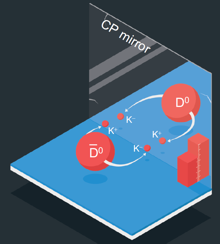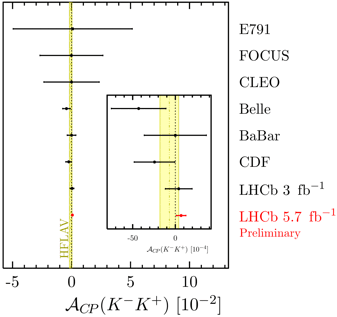The International Conference on High Energy Physics, ICHEP 2022, ended today in Bologna (Italy). At this conference, the LHCb collaboration reported a new measurement of the CP-violating asymmetry, ACP, in the decay of neutral charmed mesons, the D0, into a pair of charged kaons, D0→K–K+. This result followed the exciting result of March 2019, in which the collaboration discovered CP violation in charm-particle decays by measuring the CP asymmetry difference, ΔACP=ACP(K–K+)-ACP(π–π+). This result raised the question of whether the observed difference reflects the CP violation in the D0 meson decays into a pair of kaons, into a pair of pions, or both. The results presented at ICHEP help to answer this question. By combining the ICHEP results with the ΔACP value and other LHCb measurements the LHCb physicists obtained the direct CP asymmetries separately for the two decay modes, adK–K+ and adπ–π+. The compatibility of adπ–π+ with the hypothesis of CP symmetry is 3.8 standard deviations, therefore its value constitutes the first evidence for CP violation in a specific charm hadron decay. [for experts: all CP asymmetries discussed in this article are time-integrated, but contributions from the time-dependent CP violation have been subtracted in adK–K+ and adπ–π+.]
LHCb physicists studied the differences in decay rates of neutral D0 and D0 mesons decaying into K+K– pairs. In practice, the measurement consists in counting the numbers of D0 and D0 mesons decaying into K+K– meson pair present in the data sample recorded by LHCb in proton-proton collisions at 13 TeV and corresponding to an integrated luminosity of 5.7 fb-1. However, the K–K+ decays are identical for D0 and D0 mesons: how can one tell if the decaying meson is D0 or D0? LHCb physicists used an interesting experimental trick to answer this question. D0 and D0 mesons are produced from D*+(-) meson decays, D*+ → π+D0 and D*- → π–D0. The presence of a π+ at this point in the decay chain indicates the presence of a D0 meson, whereas a π– accompanies a D0 meson. However, because the production of D*+ mesons differs from that of D*– mesons, a large chain of control channels are a necessity to identify the true signals of CP violation in the D0 decay. In this way new insights have led to a crucial, additional improvement in precision far beyond the original expectations.
The value of the CP asymmetry, ACP(K–K+), reported at the conference, is [6.8±5.4(stat)±1.6(syst)]x10-4. A combination of CP asymmetries measured by LHCb is performed, including ACP(K–K+) previously measured at the proton-proton collisions at 7 and 8 TeV, as well as ΔACP, and the values of adK–K+ = (7.7±5.7)x10-4 and adπ–π+ = (23.2±6.1)x10-4 have been obtained for the direct CP violation in the K–K+ and π–π+ decays. The significance of the deviation from zero corresponds to 1.4 and 3.8 standard deviations, respectively, indicating in this way the first evidence for CP violation in a specific charm hadron decay.
The left image above compares the result reported here with the previous LHCb measurement and with the results of other measurements. The right image shows the contours of the direct CP asymmetry for the D0 meson decay into K–K+ and π–π+ pairs. The new measurement of adK–K+ improves the precision significantly and leads to evidence that adπ–π+ is different from zero.
CP violation is one of the key ingredients required to explain why today’s universe is only composed of matter particles, with essentially no residual presence of antimatter. The phenomenon was first observed in 1964 in the decay of neutral K mesons, and two of the physicists who made the discovery, James Cronin and Val Fitch, were awarded the Nobel Prize in physics in 1980. Such a discovery came as a great surprise at the time, as it was firmly believed by the community of particle physicists that the CP symmetry could not be violated. In the early 1970s, building on the foundations laid by Nicola Cabibbo and others some years before, Makoto Kobayashi and Toshihide Maskawa realised that CP violation could be included naturally in the theoretical framework, that we know today as the Standard Model of particle physics, provided that at least six different quarks existed in nature. Their fundamental idea was confirmed eventually three decades later by the discovery of CP violation in beauty particle decays by the BaBar and Belle collaborations, leading to the award of the 2008 Nobel Prize in physics to Kobayashi and Maskawa. In the Standard Model, the existence and overall size of CP violation are determined by a single parameter, though the way it manifests in a particular decay is influenced by several others. The values of these fundamental parameters can be determined experimentally by measuring many different CP-violating processes. The combined set of these measurements, many of which have been performed by LHCb, agree very well with the Standard Model predictions for all CP-violating effects known so far in particle physics. The Standard Model also predicts a tiny amount of CP violation in charm particle decays, at a level that is difficult to calculate exactly but could be up to 10-3 – 10-4 in decay modes of interest. Making predictions of specific single ACP observables is difficult, but comparing CP asymmetries between different channels is much more theoretically robust. As such, it is essential to make more high-precision measurements of ACP parameters in different decays, starting with the individual KK and ππ asymmetries from ΔACP.
Read more in the ICHEP presentation, in the CERN Courier article and in the forthcoming paper.



